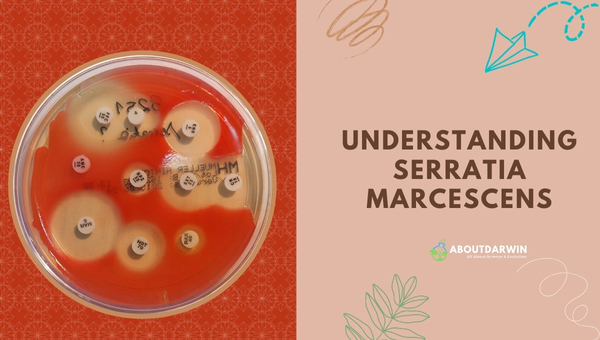Physical Address
304 North Cardinal St.
Dorchester Center, MA 02124
Bacteria are fascinatingly diverse, each species carrying its own unique characteristics and implications. As a microbiologist, one bacteria species that has often been the topic of discussion in our medical and scientific community is Serratia marcescens.
A gram-negative bacterium isolated first from soil, this distinct microorganism has intrigued us with its unique features.
Getting up close with Serratia marcescens offers fascinating insights not just into how this organism functions but also its significant contributions to the field of science and medicine. However, identifying it amongst the plethora of other microorganisms requires specific sets of biochemical tests.
Contents
The first time I came across Serratia marcescens, it felt like I was uncovering a hidden marvel in the world of microbiology. A rod-shaped bacterium from the family of Enterobacteriaceae, Serratia marcescens thrives in many diverse environments – anywhere from soil and water to our very own human intestine.

But there’s more than just vibrant color to this bacterium; it’s an opportunist for sure. It’s not weird when you think about how we all seize opportunities when they come along, right? So does Serratia marcescens.
It has a knack for turning hospital equipment into its playground, which, unfortunately, can potentially lead to infections in patients who have lowered immune systems or debilitating diseases. Indeed, where there is vulnerability, there is opportunity – an approach adopted by not just us humans but also these tiny microbes!
What truly fascinates me about Serratia marcescens, though, are the various tools researchers use to identify it correctly! You wouldn’t imagine the set of biochemical tests involved – each one as intriguing as the next – that offer not only clear identification but also valuable insights into this extraordinary bacterium’s behavior and characteristics.
Also Read: Isostatic Rebound: Uncovering Post-glacial Rebound Process
This is a basic table that you should see once. Further, we will see in detail as we move forward:
| Basic Characteristics | Properties (Serratia marcescens) |
|---|---|
| Gram Staining | Negative (-ve) |
| Fermentation of Glucose | Positive (+ve) |
| Motility | Positive (+ve) |
| Nitrate Reduction | Positive (+ve) |
| Catalase | Positive (+ve) |
| OF (Oxidative-Fermentative) | Facultative Anaerobes |
| Gelatin Hydrolysis | Positive (+ve) |
| Urease | Positive (+ve) |
| Citrate | Positive (+ve) |
| Indole | Negative (-ve) |
| MR (Methyl Red) | Negative (-ve) |
| VP (Voges Proskauer) | Positive (+ve) |
| Oxidase | Negative (-ve) |
| H2S | Negative (-ve) |
| Flagella | Positive (+ve) |
| Shape | Rods |
| Capsule | Negative (-ve) |
| Gas | Variable |
| Spore | Negative (-ve) |
As you might already know, the world of microbiology is vast and fascinating. One tiny creature that particularly grabs my attention is Serratia marcescens, a bacterium with remarkable contributions to science and medicine.
In scientific research, Serratia marcescens plays a crucial role due to its diverse capabilities. It’s an opportunistic pathogen frequently used as a model organism in microbial studies due to its natural proficiency for genetic transformation. This means it can exchange genetic material freely, making it an excellent tool for investigating genetic-related issues.
On the medical front, this bacterium has both friends and foes alike. While on the one hand, some strains of Serratia marcescens can cause bacterial infections in humans, on the other hand, scientists are leveraging this microorganism’s properties to develop novel treatments for various diseases ranging from cancer to antibacterial-resistant infections.
When it comes to the identification of Serratia marcescens, a bacteria often found in diverse environments like soil, water, and even within animals – these microscopic marvels throw several hints our way.
The physical indicators are often the first giveaway. For instance, if you’ve ever noticed colonies of bacteria sporting a distinctive red pigment on moist surfaces – that’s your first clue towards spotting Serratia marcescens.
But visuals alone don’t provide enough confirmation; we need more solid evidence. That’s where biochemical tests come into play, and there are quite a few that are particularly helpful with detecting Serratia marcescens: lactose fermentation test, oxidase test, and MacConkey agar plate test, to name a few.
The lactose fermentation test examines whether or not a bacterium can ferment lactose – something Serratia marcescens cannot do. On the other hand, an oxidase test determines if certain enzymes exist within the bacterium – enzymes lacking in this particular species.
Similar tests continue down this line of questioning, each providing an additional layer of supportive evidence toward identifying Serratia marcescens accurately.
Also Read: Arteries and Veins: Understanding Differences and Impacts on Health
Let me break down the common tests used to identify Serratia marcescens:

In the first test, we examine if the bacteria can ferment lactose. Serratia marcescens typically doesn’t ferment lactose, which sets it apart from many other types of bacteria.
We also run an oxidase test. Many species of bacteria produce an enzyme called oxidase and show a color change when exposed to a particular reagent. But interestingly, Serratia marcescens is oxidase negative.
This is another important test used for identification. It’s based on the principle that certain bacteria grow differently on MacConkey agar plates than others do, allowing us to differentiate between them visually.
If you ever see these plates in person, you will notice that colonies of Serratia marcescens are usually colorless or pale because they cannot ferment lactose into acid.
Some other distinguishing tests like the DNase test (which tests for deoxyribonuclease activity), Simmons citrate agar test (which tests if the bacterium can utilize citrate as its carbon source), and urea broth culture (Tests for the ability of the bacterium to produce urease) are also conducted and often help in drawing definitive conclusion about presence or absence of this unique type of organism.
While there isn’t one single magic trick that pinpoints our sneaky friend immediately – it’s this combination of methods that helps us confidently identify it by elimination and matching characteristics.
After initial testing for Serratia marcescens, there are certain follow-up processes and procedures necessary to ensure the complete identification and understanding of this bacterium.
The initial tests might provide a major hint towards the presence of Serratia marcescens, but confirming its presence or absence with 100% certainty requires further investigation. This way, we uphold scientific rigor right from the laboratory where these tests take place.
At such stages, confirmatory testing methods come into play to support the preliminary findings. So, just like many mysteries in life, discovering the subtle nuances of bacteria like Serratia marcescens is a multi-step journey – you could say it’s a detective story on a microscopic scale!
Also Read: Streptococcus Canis: Biochemical Test & Identification
DNase (25°C), lipase (corn oil), gelatinase (22°C), lysine decarboxylase, ornithine decarboxylase, l-arabinose, d-arabitol, d-sorbitol, adonitol and dulcitol.
S. marcescens uses citrate to produce pyruvic acid. Thus, it can rely on citrate as a carbon source and test positive for citrate utilization. In identifying the organism, one may also perform a methyl red test, which determines if a microorganism performs mixed-acid fermentation.
As a countermeasure, a real-time PCR assay was constructed for the rapid diagnosis of S. marcescens septicemia. This assay indeed detected S. marcescens in clinical blood specimens.
The pigmentation of Serratia marcescens depends on the composition of the cultivation medium. The cultures grown on glycerol-peptone medium and on the medium with acetate are red and yellow (yellowish orange), respectively, with the color depending on the ambient pH.
In the end, Serratia marcescens is not just any ordinary bacterium. With its distinctive characteristics and substantial role in both medicine and microbiology, gaining an accurate understanding of this organism involves a series of intricate biochemical tests. These tests offer invaluable insights that aid in diagnosis, prevention, and further research.
Essentially, the scientific journey from initially suspecting its presence to confirming its identification is a remarkable process. It combines diligent observation with cutting-edge technology and proves how intricate our fight against microscopic enemies like Serratia marcescens really is.
Through the pursuit of knowledge such as this, we continue to advance in our understanding of such microbes and equip ourselves better for future challenges they may present.